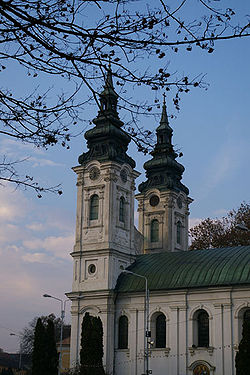Lugoj
| Lugoj | ||
|---|---|---|
| Municipality | ||

Baroque Orthodox Cathedral
|
||
|
||
 Location of Lugoj |
||
| Coordinates: 45°41′10″N 21°54′2″E / 45.68611°N 21.90056°ECoordinates: 45°41′10″N 21°54′2″E / 45.68611°N 21.90056°E | ||
| Country |
|
|
| County |
|
|
| Status | Municipality | |
| Government | ||
| • Mayor | Francisc Boldea (PSD) | |
| Area | ||
| • Total | 88.05 km2 (34.00 sq mi) | |
| Population (2011) | ||
| • Total | 37,700 | |
| Time zone | EET (UTC+2) | |
| • Summer (DST) | EEST (UTC+3) | |
| Climate | Cfb | |
| Website | http://www.primarialugoj.ro/ | |
Lugoj (Romanian pronunciation: [ˈluɡoʒ]) is a city in Timiș County, Banat, western Romania. The Timiș River divides the city into two halves, the so-called Romanian Lugoj that spreads on the right bank and the German Lugoj on the left bank. It is the seat of the Eparchy of Lugoj in the Romanian Church United with Rome, Greek-Catholic. The city administers two villages, Măguri and Tapia.
In German: Lugosch; in Serbian: Lugoš (Лугош); in Hungarian: Lugos; in Turkish: Logoş. In Hungarian, Măguri is called Szendelak, and Tapia is known as Tápia.
Lugoj was once a strongly fortified city that developed along the Timiș River. During the Middle Ages and eighteenth century, it was of greater relative importance than at present.
A diploma dated Wednesday 22 August 1376, signed by King Sigismund of Luxemburg, shows that Lugoj city was donated to landowners Ladislaus and Stephen Loszonczy. At the end of the 14th century, after the Battle of Nicopolis (1396), the Turks crossed the Danube, invading Banat and reached the gates of Lugoj. During major campaigns against the Turks, Hunyadi, as a comite of Timis (1440), took steps to organize the city's defense system. He strengthened the city with trenches, ramparts and palisades.
The Banate of Lugoj-Caransebeș resisted Ottoman pressures until 1658, when Ákos Barcsay, Prince of Transylvania, asked Lugoj and Caransebeș to accept the decision taken by the Diet of Sighișoara to agree to Turkish occupation.
...
Wikipedia

